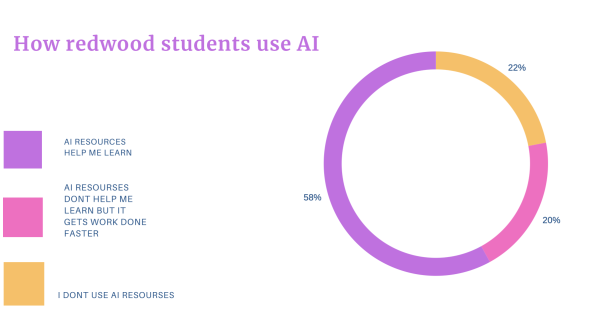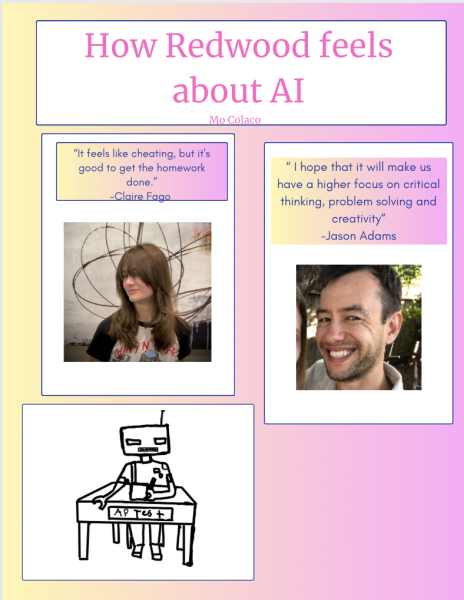After long hours of lectures in class, a science lab to complete, sports practice and extracurriculars, that one math assignment may just be the final thing to throw you over the edge.
Often students in this position may be faced with a dilemma: do they muster up the energy to finish the algebra homework or instead simply click on the enchanting red PhotoMath logo and have their work done in a fraction of the time? Using external Artificial Intelligence (AI) resources can seem like no big deal, but the number of students who constantly rely on AI shows how much of a change this could cause for modern-day education. 
AI isn’t all bad for students’ learning; math teacher Jason Adams has seen AI be a helpful tool for the students in his class. However, he also sees it being used to complete work, with no learning involved.
“I see some students using [AI math problem] solvers with steps and then using that to learn the parts that they don’t know, then some students are using it to just copy down [the work] without the learning,” Adams said.
Adams also notes that students are different, and have varying motives for why they rely on AI rather than spending more time working on their homework.
“They either have too many commitments or [their] time is stretched and they don’t want to put in the time necessary [to complete their work],” Adams said.
Students often rely on AI sources to get the work done quickly. Unlike previous generations, Gen Z has the option to spend time doing mindless activities like watching TikTok or spending time outside instead of doing homework. Because of the new AI sources, the quick paragraphs that appear on your screen in under two seconds give you all the information you need and more. Students, who are already overwhelmed and tired from lack of sleep, obviously choose to let the learning be done for them. Sophomore Claire Fago often uses AI when she is struggling to understand a concept.
“It feels like cheating, honestly, but it’s good to get the homework done,” said Fago.
 Although students may resort to AI when they can’t grasp the content, it is possible that using AI can make the issue even worse — AI can create a repeating cycle of not understanding, resorting to even greater reliance on online tools, and then still not gaining the understanding to complete the next assignment.
Although students may resort to AI when they can’t grasp the content, it is possible that using AI can make the issue even worse — AI can create a repeating cycle of not understanding, resorting to even greater reliance on online tools, and then still not gaining the understanding to complete the next assignment.
Having an easily available source that allows you to solve a math problem in seconds could affect our generation’s overall quality of work. According to the June 2023 American College Testing (ACT) survey of sophomores and seniors, 46 percent of students rely on AI. This terrifying number can explain how students’ work will continue to adapt and rely on this tool, and when they don’t have it, being left confused.
According to the 2024 Bark survey, 20 percent of students at Redwood use AI to complete their schoolwork, without understanding the concepts. This means there will be potentially 20 percent of students who eventually graduate from Redwood not being fully educated in the topics found in classrooms.
Furthermore, 58 percent of students reported using AI resources and that they help them learn. Over half of Redwood students learn from AI, which shows how impactful these tools could be to our generation’s education. Students who rely on apps such as Photo Math for their math homework could be left stunned on the SAT when the problems don’t have a “solve for me” button. Or, where can our mind reach for a creative description of a tree without chat GPT’s assistance?
Fiona Allan, an AP language and composition teacher along with freshman English, has insight into how she thinks AI is warping many generations’ careers.
“I think the corners that are being cut are already being seen in the world, think of Boeing, doors are blowing off of airplanes. People are cutting corners,” said Allan.
Allan continues to add how she believes that schools are changing their processes due to the lack of genuine work.
“Students are starting to see that schools are going back to standardized testing because it’s an authentic reflection of how students are doing without AI,” said Allan.
Sophomore Ethan Ferry describes how his experiences with AI are positive for short-term goals but can corrupt long-term goals in education.
“Long-term, AI [won’t be successful] because you won’t be learning anything, if you are writing all your English essays through AI you’re not even doing the work,” Ferry said.
While AI can be used as a substitute for learning, the tool can also enhance students’ understanding by teaching them the correct steps to solve problems, as Adams pointed out previously
“We’re able to use our brains to problem solve and creatively kind of get away from execution and more interpretation and critical thinking,” Adams said.
Furthermore, Ferry thinks the advantage of using AI is to inspire creativity and diversity within his work.
“It helps me with getting ideas for essays, and [evolving] them faster,” Ferry said.
According to the University of the People, the future of AI is simple; it isn’t going anywhere, incoming and graduating students must learn how to use it responsibly and correctly to help them learn, and not replace learning as a whole.
The help AI provides students with is bittersweet; although the tool helps students push through hard concepts and generate new ideas, the long-term effect of using a crutch to get through topics they will later be tested on leaves a permanent mark on this generation’s ability to internalize and complete challenging work.







